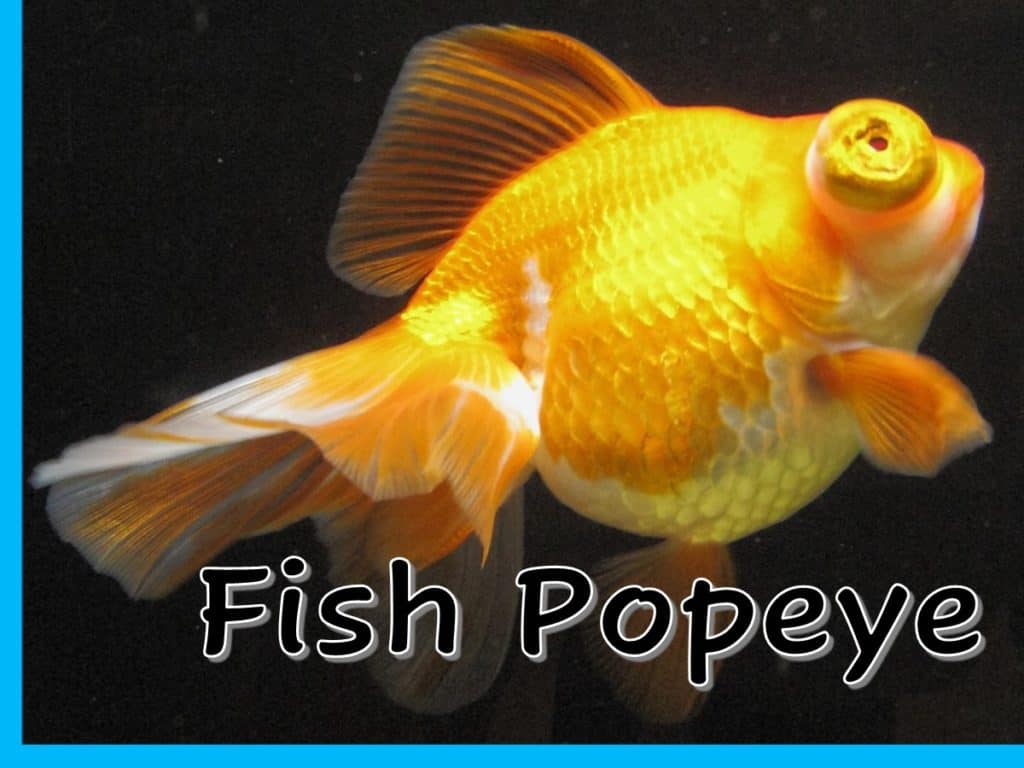No, not a cartoon character, but rather a physical descriptor. Fish popeye is another common problem we run into at our practice. What is “popeye” and how can it be treated? Is there a way to prevent it in your fish?
Classifications of Fish Popeye
Fish popeye cases are termed exophthalmia in medical speak. It may be asymmetrical or bilateral. Depending on the cause it can be a more mild case, brought on gradually, or more severe. If you are concerned about your fish’s eyes, it is important to get good photographs or videos showing the progression of any eye issues.
Common Causes of Fish Popeye
The #1 cause of fish popeye is trauma. Usually, a fish gets spooked or super excited and runs into something, damaging the eye. If the globe itself isn’t damaged, sometimes swelling just behind the eye can push it outwards, a condition technically called exophthalmia. Some species of fish, and varieties of fancy goldfish, are predisposed to popeye due to their anatomy. Fish such as black moors, who already have protruding eyeballs, are more prone to injury and trauma.
The second most common cause of fish popeye is internal swelling. Freshwater fish are constantly taking on water, and the gills and kidneys are responsible for removing the excess. (Also why your fish cannot be “constipated.”) If your fish’s kidneys and/or gills are not functioning correctly, the fish’s body starts to take on excess moisture. This can build up in the tissues behind the eye, making it stick out. Since this is a secondary clinical sign, it is critical to identify the cause of kidney or gill dysfunction and correct it before the popeye is corrected. (#1 cause = poor water quality)
Some with with popeye may be completely normal. Some varieties of fancy goldfish, such as the one pictured below, have been bred to have protruding eyeballs. These may be predisposed to more frequent trauma, so be sure your tank is free of any potentially hazardous decorations.
Koi also show a wide variety of eyeball positions. Throughout the same pond, some koi may have tucked in eyeballs whereas others protrude a few millimeters. It is best to check back through your photos of your fish to see if the eyeball position has changed over time.

How do I treat popeye in fish?
If your fish suffered a traumatic event, the best treatment is good water quality, a good diet, remove the cause of the trauma, if possible, and time. Some injuries may be so severe that the eye does not go back to normal, but your fish’s vision may still be okay. Even if your fish loses vision in that eye, you will probably not realize it. Fish do just fine with one eye or no eyes. Their other senses, including sound, smell and their lateral line, easily compensate for a lack of vision.
If your fish’s kidneys or gills are not functioning correctly, it’s time to do some problem solving. Check your water chemistry FIRST and make sure it is within the correct parameters. If any of the parameters are out of range, make a plan to correct it. Remember: any issues with pH or temperature must be made SLOWLY! If water quality isn’t the cause, don’t just reach for whatever over-the-counter product looks best. Call a professional to get to the bottom of the problem quickly and cost effectively.
How to Prevent Popeye
Unfortunately, other than removing potential traumatic decor, there is no guaranteed method to prevent popeye in your fish. The best plan is to set you fish up for success by maintaining good water quality with a regular maintenance plan, feeding a good diet and monitoring your fish regularly for any signs of illness or disease.

Pingback: "Popeye" in Pet Fish - PETS YELPS
How do I treat for Popeyes on my koi the water level are good I recently had leech’s and I am not sure what could corse it to happen
If you are concerned about your fish, please call (831) 278-1081 for veterinary assistance. If you are outside California and Nevada, please visit https://fishvets.org or https://wavma.org
Very helpful, thank you. I guess France is a bit out of your area 😂
Pingback: Why Does My Puffer Fish Have Cloudy Eyes?
Pingback: Síntomas, causas y opciones de tratamiento del pez Oscar Popeye
Pingback: Why Your Goldfish Is Not Eating: 10 Vet-Reviewed Reasons - Barky.com.au
Pingback: Why Your Goldfish Is Not Eating: 10 Vet-Reviewed Reasons - Nirantara - Pet Care
Pingback: Why Your Goldfish Is Not Eating: 10 Vet-Reviewed Reasons - MeowMyBark
Pingback: Why Your Goldfish Is Not Eating: 10 Vet-Reviewed Reasons - McKinney News Source
Pingback: Why Your Goldfish Is Not Eating: 10 Vet-Reviewed Reasons - BEST PETS DEALS
Pingback: Why Your Goldfish Is Not Eating: 10 Vet-Reviewed Reasons | Pet Keen - The Philippine Sunrise
Pingback: Why Your Goldfish Is Not Eating: 10 Vet-Reviewed Reasons - Nashville News Source
Pingback: Why Your Goldfish Is Not Consuming: 10 Vet-Reviewed Causes - petninsula
Pingback: Why Your Goldfish Is Not Eating: 10 Vet-Reviewed Reasons – Happy pets guide
Pingback: Why Your Goldfish Is Not Eating: 10 Vet-Reviewed Reasons | PangoVet
Pingback: Why Your Goldfish Is Not Eating: 10 Vet-Reviewed Reasons - Pet Follower | Pet Guides, Health & Gear Articles by Pet Lovers & Veterinarians